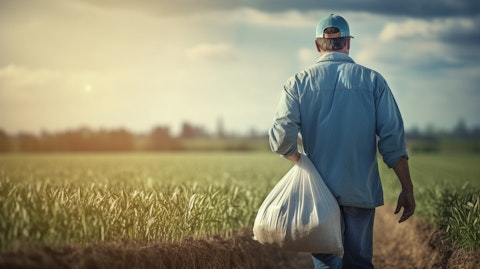Central Garden & Pet Company (NASDAQ:CENT) Q2 2025 Earnings Call Transcript May 10, 2025
Operator: Ladies and gentlemen, thank you for standing by. Welcome to Central Garden & Pet’s Fiscal 2025 Second Quarter Earnings Call. My name is Zeko, and I will be your conference operator for today. [Operator Instructions] As a reminder, this conference call is being recorded. I will now turn the call over to Friederike Edelmann, Vice President, Investor Relations. Please proceed.
Friederike Edelmann: Good afternoon, everyone, and thank you for joining Central’s Second Quarter Fiscal 2025 Earnings Call. Joining me today are Niko Lahanas, Chief Executive Officer; Brad Smith, Chief Financial Officer; John Hanson, President, Pet Consumer Products; and J.D. Walker, President of Garden Consumer Products. Niko will start by sharing today’s key takeaways, followed by Brad, who will provide a more in-depth discussion of our results. After their prepared remarks, J.D. and John will join us for the Q&A Session. Before we begin, I would like to remind everyone that all forward-looking statements made during this call are subject to risks and uncertainties that could cause our actual results to differ materially from what those forward-looking statements expressed or implied today.
A detailed description of Central’s risk factors can be found in our annual reports filed with the SEC. Please note that Central undertakes no obligation to publicly update forward-looking statements to reflect new information, future events or other developments. Our press release and related materials, including GAAP reconciliation for the non-GAAP measures discussed on this call are available at ir.central.com. Lastly, unless otherwise specified, all comparisons discussed during this call are made against the same period in the prior year. If you have any additional questions after the call or at any time during the quarter, please don’t hesitate to contact me directly. With that, let’s get started. Niko?
Niko Lahanas: Thank you, Friederike, and good afternoon, everyone. I’d like to begin by outlining the three takeaways from today’s call. First, a solid second quarter, driven by outstanding execution from Team Central. Second, further advancements in streamlining our business and enhancing efficiency through footprint consolidation, portfolio refinement and cost structure improvements, setting us up for future growth. And third, confidence in our outlook for the year, even as we navigate a more challenging environment in the second half of the fiscal year. Now let me expand on these points. First, our second quarter achievements. As previously indicated during our first quarter earnings call, the earlier timing of preseason orders and promotional events shifted sales forward into the first quarter, leading to softer sales during the second quarter.
Compounding this, unseasonably cold and wet weather in March delayed the start of the garden selling season, further impacting sales. In addition, the loss of two product lines in our third-party Garden Distribution business placed additional pressure on our top line. Nevertheless, our team’s focus on execution drove growth in both GAAP and non-GAAP earnings per share, meaningful margin improvement and record non-GAAP operating income within our Pet segment. A particular highlight of the second quarter was the performance of our Wild Bird business, which benefited from the extended cold weather and achieved record sales. We’re extremely pleased with the consistent growth these teams have delivered over time. Moreover, our e-commerce sales performance remained strong, reflecting the continued success of our enhanced digital capabilities.
We’re proud to report that our brands held the number one online sales position in both the Wild Bird and Grass Seed categories. These achievements are a testament to the dedication, resilience and hard work of our over 6,000 employees who continue to drive our success and position us to build an even stronger future. Second, Cost and Simplicity program. Our Cost and Simplicity program continues to deliver significant results. Completed initiatives are producing tangible benefits, and we are introducing new projects. Highlights of the second quarter include e-commerce expansion. We recently upgraded our distribution center in Eastern Pennsylvania by adding direct-to-consumer or DTC capabilities. The facility is already delivering strong results, having shipped more than 10,000 packages directly to consumers.
With enhanced capacity, the center strengthens our ability to efficiently manage and fulfill both our own DTC business as well as drop shipments for our retail partners, fueling our growing e-commerce momentum. Designed with higher ceilings and more doors to move product quickly, the upgraded center not only improves operational flow, but also significantly enhances employee safety, a top priority for us. Building on this success, we are excited to be on track to consolidate two older distribution centers in Ontario, California and Salt Lake City, Utah into a new DTC-enabled facility in Salt Lake City later this fiscal year. This move should further strengthen our logistics network, drive significant cost savings and position us for future growth.
Optimizing our logistics for growth, we are pleased to announce the opening of our new 300,000 square foot dog and cat distribution center in New Jersey. This facility centralizes all warehousing, shipping and receiving operations for the business unit, including direct-to-consumer picking, packing and shipping. This expansion is a major step forward in boosting productivity and operational efficiency, while positioning us for continued growth in one of our fastest-growing categories, rightsizing our footprint. In our Pet segment, we began winding down our UK operations and are transitioning to a direct export model, servicing the UK and certain European markets directly from the United States. These initiatives are integral to our broader strategy to streamline Central, enhancing agility and efficiency.
They position us for margin expansion while freeing up resources to drive organic growth, pursue strategic M&A and uphold our commitment to social responsibility and environmental stewardship. Third, confidence in our outlook for the fiscal year. We delivered a strong first half with earnings well above the prior year period. Looking ahead to the remainder of the fiscal year, recent tariff actions and related geopolitical tensions have significantly increased macroeconomic uncertainty and weighed on consumer confidence. Assuming current tariff rates remain in effect, we anticipate heightened inflationary pressures in the second half, particularly within the Pet segment. As a result, we expect the following: increased consumer caution and a heightened focus on value, a more promotional retail environment and further pressure on the pet specialty brick-and-mortar channel.
Given the increasing unpredictability of weather patterns evident in this year’s delayed start, we factored this variability into our forward-looking expectations. Importantly, when conditions are favorable, consumer engagement in lawn and garden remains strong. And with the bulk of the season still ahead, we remain cautiously optimistic on the remainder of the garden season. After carefully considering the uncertainty ahead and our plans to manage the second half, we are reaffirming our fiscal 2025 guidance for non-GAAP EPS of $2.20 or higher, underscoring our commitment to delivering long-term value to shareholders. Looking ahead, we will continue to prioritize disciplined cost and cash management while investing strategically in organic growth, particularly in e-commerce, digital technology and innovation.

Our M&A strategy remains focused on accelerating growth initiatives, expanding capabilities and strengthening our portfolio for the future. With that, I’ll turn it over to Brad. Brad?
Brad Smith: Thank you, Niko. Expanding Niko’s key takeaways, I’ll share an overview of our second quarter results, including the performance of our two segments and our outlook for the fiscal year. Now let’s start with our second quarter performance. Net sales were $834 million, a decrease of 7%. Gross profit of $273 million was down 2%, while gross margin expanded by 180 basis points to 32.8%. The margin improvement is being driven primarily by the successful execution of our Cost and Simplicity program. SG&A expense of $180 million was 3% below the prior year, reflecting continued cost discipline across our businesses. However, given the lower sales, SG&A as a percentage of net sales expanded by 100 basis points to 21.6%.
Non-GAAP operating income of $99 million was in line with the prior year, while non-GAAP operating margin expanded by 80 basis points to 11.8%. Non-GAAP adjustments for the quarter are related to the strategic wind-down of our UK operations, a Cost and Simplicity initiative we launched in the second quarter. Moving to a direct export-only model to service the UK and certain European markets is expected to reduce cost and operational complexity and improve our overall profitability. As a result of this initiative, we incurred an initial noncash charge of $5.3 million, including $4.4 million in cost of goods and $900,000 in SG&A. Below the line, net interest expense was $9 million compared to $11 million in the prior year, driven by higher interest income as a result of larger cash balances.
Other income was $744,000 compared to other expense of $171,000 a year ago. Non-GAAP net income totaled $68 million, an increase of 3%. We delivered non-GAAP EPS of $1.04, an increase of $0.05. GAAP earnings per share also rose by $0.05, coming in at $0.98. These results underscore the strength of our operations and the positive momentum we are maintaining across the business. Adjusted EBITDA of $123 million was $1 million below the prior year quarter. Our tax rate for the quarter was 23.5%. Now I’ll provide highlights from our two segments, starting with Pet. Pet net sales totaled $454 million, a decrease of 6%, primarily driven by the earlier timing of customer orders and promotional events, which shifted sales into the first quarter. The decline also reflects our strategic decision to exit lower-margin SKUs and durables, which we accelerated toward the end of last fiscal year in response to softer demand and increased pricing pressure.
Consumable sales were relatively flat compared to the prior year, while durable sales were down double digits with points of sale, or POS, an indicator for consumer demand, slightly outpacing both categories. Overall, we held market share with strong share performance in several key categories, including Dog Chews, Rawhide and Equine. E-commerce sales represented 27% of pet sales, up versus the prior year, fueled by the introduction of new products, optimized retail media efforts and enhanced conversion rates. Non-GAAP operating income for Pet reached $66 million, up 5% and a record second quarter for the segment. Non-GAAP operating margin expanded by 150 basis points to 14.5%, driven by productivity gains resulting from our Cost and Simplicity program.
Lastly, Pet segment adjusted EBITDA totaled $75 million, up $2 million. Now moving to Garden. Garden net sales totaled $380 million, a 10% decrease, primarily due to the earlier timing of customer orders, which shifted sales into the first quarter, a delayed start to the spring season that impacted sales across Garden categories and the loss of two product lines in our third-party distribution business. These declines were partially offset by the record sales we saw in our Wild Bird business across channels. Overall, POS trends were down low single digits, reflecting the delay in the garden selling season for our traditional Garden categories, offsetting the strong consumer demand in our Wild Bird business. Overall share performance was strong in the second quarter with share gains across key categories, including Wild Bird, Grass Seed, Chemicals and Fertilizer.
Exceptional in-store execution by our merchandising teams played an important role in driving these results. Garden e-commerce sales delivered another strong quarter of double-digit growth, led by outstanding performance in Wild Bird and Grass Seed across pure-play and omnichannel retailers. This momentum was fueled by the introduction of new product offerings, enhanced content and centralized retail media initiatives, which drove higher engagement and improved conversion rates across accounts and business units. GAAP operating income for Garden of $59 million was up $2 million. GAAP operating margin was 15.5%, an increase of 190 basis points driven by productivity gains. Finally, Garden segment adjusted EBITDA was $69 million compared to $73 million.
Let me now address the balance sheet and cash flows. Cash used by operations was $47 million for the quarter versus $25 million a year ago. Our ongoing focus on working capital management led to further inventory reductions of $90 million in the second quarter across both segments of our business. CapEx for the quarter was $11 million, 14% below the prior year, reflecting disciplined investments, primarily in productivity enhancing initiatives and essential maintenance projects. Depreciation and amortization of $21 million was 9% below the prior year quarter. During the quarter, we repurchased approximately 1.2 million shares or $41 million of our stock. We purchased an additional 1.2 million shares or $39 million of our stock through the end of April.
As of the end of April, approximately $63 million remained available under the share repurchase program. Cash and cash equivalents at the end of the second quarter were $517 million, an increase of $215 million. Total debt of $1.2 billion was in line with the prior year. We ended the quarter with a gross leverage ratio of 2.9 times, in line with the prior year quarter and below our target range of 3 to 3.5. Factoring in our strong cash position, our net leverage ratio was around 1.7 times. We continue to have no borrowings under our $750 million credit facility. With our strong financial position, our M&A strategy continues to prioritize identifying high-growth consumable companies with accretive margins. Our objective is to scale core categories, strategically expand into adjacent markets and strengthen key capabilities to drive sustained growth and long-term value creation.
Turning to our fiscal ‘25 outlook. As Niko highlighted, we are reaffirming our guidance for non-GAAP EPS of $2.20 or higher for the full fiscal year. This outlook takes into consideration anticipated shifting consumer behavior amid macroeconomic and geopolitical uncertainty, challenges within the brick-and-mortar retail landscape and the weather variability anticipated for the remainder of the year. It underscores the confidence we have in our strategy, our action plans and our team’s ability to manage through these challenges. Regarding CapEx, we expect to invest approximately $60 million during fiscal ‘25. These investments will be directed towards initiatives that enhance productivity and support essential maintenance across both segments of our business, positioning us well for future growth.
Please note that our fiscal ‘25 outlook does not incorporate potential impacts from further changes in tariff rates or from acquisitions, divestitures or restructuring activities that may occur during the fiscal year, including actions related under our ongoing Cost and Simplicity program. We would now like to open the line for questions.
Q&A Session
Follow Central Garden & Pet Co (NASDAQ:CENT)
Follow Central Garden & Pet Co (NASDAQ:CENT)
Receive real-time insider trading and news alerts
Operator: Thank you. Ladies and gentlemen we will now be conducting a question-and-answer session. [Operator Instructions] Our first question comes from Bill Chappell with Truist Securities. Please go ahead.
Bill Chappell: Thanks. Good afternoon. Can you talk a little bit more just about the pet trends and in particular, kind of the durables versus consumables, what you’re seeing, kind of how the quarter ended up and just kind of the outlook as we move through this summer?
John Hanson: Bill, this is John. Yes, I can jump into that. So for Q2, our net sales were down 6%. And as we mentioned, we had customer pull forwards due to seasonality, seasonal events and promotional events in Q1. And that, combined with some proactive SKU rationalization we took really drove that down 6%. If you look at our business on a half, we were down 1%. And we feel like we – from the data we’ve got, we held a share. Right? And then a couple of other key data points, I think, are important. One is consumables for the half were up low to mid-single digits, 3% range, and e-com was up corresponding kind of low to mid-single digits. So, our focus has been on driving e-com growth, driving consumables. It’s margin accretive.
And the durable category continues to be challenged. If you look at it in total, it was down double digits, somewhere in that 10%, 11% range. We were down a couple of points worse due to our SKU rationalization efforts. And if I think about that durable business, we have a live animal business that is starting to show some positive trends honestly. And it’s stabilizing. We’re feeling really good about the direction of it as we think about the back half. The wildcard right now is tariffs. We’re going to have to work through tariffs. A lot of durables come or imported from a variety of countries, and we’re going to have to work through that, and we’re right in the middle of working through it.
Bill Chappell: Got it, thanks.
Brad Smith: This is Brad. I would just add on the durables front that we were down, I guess, mid-teens roughly year-to-date in durables. About half of that was driven by our actions to SKU rat our business. So it was significant. If you pull that out, it’s kind of the actual residual remaining softness is kind of high single digits.
Bill Chappell: And just following up on that, because I think, most of your tariff exposure is on the Pet segment. I mean maybe more color on – what you’re doing now? I mean, are you just pausing orders until we kind of see where the pricing is? Are you – did you stockpile a fair amount of inventory beforehand? And any way to kind of quantify or what you’re going to do on pricing to offset it? Or is it just really too early?
Brad Smith: So I mean, let me answer it this way. So, if we look at our total import costs that are subject to tariff, it’s about 13% of our cost of goods. And I would say the big piece of that is China, which is about 20% of our tariffable imports spread about 80% of our exposure. Like you said, this is mostly in Pet, but we do have some in Garden. We are actively working on plans around vendor concessions, country of origin changes, SKU redesign, SKU rationalization as well as some pricing. At the end of the day, we are going to have to take some. So we’re working on all of that now. Many planned changes will not impact our P&L until Q4 or Q1 of next year. It’s going to take some time to move sourcing and to implement pricing. We do have some pre-tariff inventory levels that are also helping us to reduce our 2025 exposure as well.
John Hanson: But Bill, the wildcard is we know tariffs as of today, and they could change, right? So, we’re working the best we can with the current knowledge we have.
Niko Lahanas: Yes. I would say, overall, just to sum it up, I think the businesses have done an excellent job of preparing for this through a number of actions, one being buying a little bit forward in terms of inventories. And then the other piece is just remaining really flexible with the supply chain across the world really. And so we feel like we have a really good line of sight for the rest of the fiscal. I think 2026, we’re going to have to really take a hard look at that, which is what we’re doing right now, but we feel pretty good about the near term in terms of the tariffs and our exposure there.
Bill Chappell: Got it thanks for the color.
Niko Lahanas: Yes.
Operator: Thank you. Our next question comes from Brad Thomas with KeyBanc Capital Markets. Please go ahead.
Brad Thomas: Good afternoon. Thanks for taking my questions. I will first ask about the Garden segment, and we all are well aware that the weather has been unfavorable again so far. But hoping you could comment just a little bit more about what you’re seeing out there in the spring selling season, what you’re hearing from retailers and seeing at POS, how you feel like inventory levels are? And then any comments on the live goods specifically would be great.
J.D. Walker: Sure. Thanks, Brad. This is J.D. I’ll take that. I’d say, you nailed it at the start there talking about a delayed season that’s been widely reported by other competitors and retailers as well. A delayed season, but one of the glimmers of hope that we saw in February and March was when the weather was decent, the consumers were very engaged. So, not the start that we wanted for the year, top line, some headwinds, as we noted in the script. However, we managed our way to a solid gross margin and operating margin and results. So we feel good about that. And I’d say that since the end of Q2 and going into Q3, as the weather has improved, consumption has improved. So, that gives us an optimistic outlook. I think Niko said cautiously optimistic in his script, and I agree with that.
I do think that our team has done all the hard work in advance of the season to take advantage if the opportunity is there, and I do believe the opportunity will be there. Retailers have stayed engaged. They’re very promotional as it’s been reported right now. So, they’re trying to drive footsteps into the stores. And when the weather is favorable, as I mentioned, we’re seeing that kind of consumption. So we think we’re in a great position to succeed this year. You mentioned live goods, and I think that live goods, again, it’s a weather story more than anything else, but there’s been a lot of hard work in advance of the season. We’ve done some – the SKU rationalization has been mentioned here a couple of times. We’ve done some SKU rationalization and actually pulled out of some markets that were unprofitable for us and focusing on areas where we have a right to win.
And most of that season is still in front of us. In fact, this coming weekend, Mother’s Day weekend is typically the peak for that season. So, we feel like we’re ramping into it really well. And I think that that business year-over-year is going to perform much better than prior year. So all in all, optimistic about the year. I think the team is in a great operating rhythm and ready to succeed.
Niko Lahanas: Yes. I would just add, I think a big call out to the live goods team. They did a tremendous job in this year of really rationalizing their SKUs, being more data-driven, just an incredible job of really streamlining that business and setting it up for success. The other thing I would call out, too, is a nice offset and really testament to our portfolio is our Wild Bird business, which is really in the middle of having a record year. So, the weather there has been really helpful in terms of Wild Bird, and we’re really pleased with the results there.
J.D. Walker: Yes, the weather that’s a drag for our legacy Garden businesses was actually a tailwind for our Wild Bird business, particularly in February and January, February, March when we saw one winter storm after another that was a – it was nice to have something in the portfolio that offsets the typical lawn and garden cycle. And that Wild Bird business has been incredibly strong.
Brad Thomas: That’s very helpful, J.D. and Niko. Thank you. And if I could ask a follow-up just around tariffs. Niko, as you plan the business for the next six months and you start to hopefully get a better line of sight into where some of the tariffs are going to settle out. Can you help us just think about: number one, how significant the changes you may need to make in supply or how significant the changes in pricing may need to be for you? And to what extent do you feel like you need to look at incremental cost actions within the company?
Niko Lahanas: Yes. I think you hit on all of it. Like I said, we have a good line of sight for the next few months. In terms of Q4 is where we could see some bumpiness relative to tariffs. That’s where we’ll have to contemplate some pricing. We’re just going to continue to really look at the supply chain and really look under every rock in terms of where we can get better in terms of procuring product. And then as we outlined on our – on the prepared remarks, we’re continuing down with our Cost and Simplicity program. So really taking cost out and really becoming a more efficient, stronger organization overall. So that’s going to continue. Really glad we started that a few years ago because it’s got some really nice momentum.
And as everyone can hear on the calls, every quarter, we update folks on what we’re doing. And some really nice work being done there by the whole organization around just consolidating facilities, streamlining the organization, just becoming more efficient, taking cost out. And I think you see it in the margins, right, because revenue is down and yet margins continue to expand. And I think that’s a real sign of just really nice efficiency across the board.
Brad Thomas: Very helpful, thanks Niko.
Niko Lahanas: Yes.
Operator: Thank you. Our next question comes from Jim Chartier with Monness, Crespi, Hardt. Please go ahead.
Jim Chartier: Thanks for taking my questions. You’ve mentioned in the past Chinese online imports probably hurting your Pet business with the de minimis tariff exclusion taken away now, what are your thoughts there? I know it’s early, but have you seen any price increases online yet? And how do you see that playing out going forward?
John Hanson: Yes. We’ve definitely – this is John, Jim. We definitely mentioned that in the past. And it’s hard to get data on. We just know that those sites have had a tremendous amount of traffic, and they are selling very inexpensive pet supplies. Anecdotally, I’ve read some articles that say the costs have gone up dramatically on those sites with the de minimis tariff exception being eliminated. But I think it’s – time will tell, right? I do know that I’ve read some articles too in the Wall Street Journal that said [indiscernible], as an example, has really stopped doing direct import directly to the consumer into the U.S. So, I think it can be a tailwind for sure on durables. We’re just going to have to see what it looks like.
Niko Lahanas: Yes, we haven’t seen it really play out yet.
John Hanson: Yes.
Jim Chartier: Great. And then you mentioned the late-breaking spring season. Have you seen Garden shipments pick up here in April and May to date?
John Hanson: Jim, it’s J.D. We have – we’ve seen consumption improvement as well as shipments improvement. So, it’s playing out exactly the way we had hoped at the end of Q2, and we’re ramping into season very nicely. And again, a lot of season still in front of us. Our peak weeks are still remain in front of us. But so far, so good. So yes, we have seen improvement. Great.
Jim Chartier: And sorry if I missed it, but did you mention what the POS was for the Garden segment in the quarter or the first half?
John Hanson: I’m not sure if it was mentioned in prepared remarks or not, but it was low single digits decrease POS. And again, we mentioned that there’s a couple of large vendor partner or third-party lines that we lost this past year. If you factor those out, our POS was flat for the quarter year-over-year.
Jim Chartier: Great. Thank you.
Operator: Thank you. Our next question comes from Bob Labick with CJS Securities. Please go ahead.
Peter Lukas: Yes, hi. It’s Pete Lukas for Bob. You talked a little bit about what you’re seeing from the consumer. Are you seeing a trade down to private label or retailers starting to push that more in anticipation of a sluggish consumer?
Niko Lahanas: We have seen some trade down. It’s best represented in our Wild Bird business, where we actually have good, better, best cover the whole gamut in terms of the value chain there. And we have seen some trade down in Wild Bird, in particular to the more value type of products. So we are seeing that. Hard for us to – I’ll let J.D. talk more about private label, but hard for us to call because we just – we’re kind of midstream and taking over the private label business.
J.D. Walker: Yes, that’s right, Pete. This year, we picked up a couple of meaningful pieces of private label business at two large big box stores. And that business is doing extremely well, but we don’t have a prior year comp to compare it against. I would say that the conversion rate seems like, first of all, great execution in stores by our merchandising team is leading to great conversion for both of those brands. So, we are seeing some trade down. I believe it is it’s coming to fruition. I’d say both that and also a much deeper promotions than we’ve seen in the past few years. So, I see the consumers being more – seeking value more than we’ve seen over the last couple of years.
Peter Lukas: And I guess just a follow-up. If it does tend to – and I’m not saying it will, and I know you didn’t, but if private labels were to increase at all, how do you stand from a capacity point of view there? And how do you – we think about margin profile?
John Hanson: From a capacity standpoint in terms of – do we have the capacity to execute the programs? Yes, we absolutely do. And we feel great about this year and even next year as that – those brands continue to grow, we have the capacity to fulfill customer commitments, not a problem there. And in terms of margin, those are margin accretive opportunities for us.
Niko Lahanas: Yes. And the way to think about private label is typically what we see is a lower gross margin. But the operating margin, assuming we’re a low-cost producer and we’re efficient, can be very comparable to the branded products because you don’t have the marketing expense. A lot of times the customers pick it up. So, your SG&A tends to be much lower with private label. And as long as you’re incredibly efficient as an operator, you can print some really nice margins there. And it’s something we’ve done for a lot of years. So, it’s nothing new to us in terms of doing private label. We’ve been at it as long as I’ve been here and even before. So it’s sort of in our DNA.
J.D. Walker: And across many categories, right?
Niko Lahanas: Yes.
J.D. Walker: I mean, Wild Bird food, we do private label, we do it in grassy, we do it in fertilizer, we do it in controls products. So almost every category in which we compete, we have some private label offering.
Peter Lukas: Very helpful, thanks. I will jump back in the queue.
Operator: Thank you. Our next question comes from Brian McNamara with Canaccord Genuity. Please go ahead.
Brian McNamara: Good afternoon. Thanks for taking the question. I am curious to start out here what – how tariffs are impacting the M&A environment, both in terms of deal flow? And then I’m assuming the uncertainty isn’t helping, but I’m curious what the impact would be on the current bid-ask spread relative to what you’ve seen over the last prior three to six months. Thanks.
Niko Lahanas: Yes, you’re right. It’s not helping at all. I was just listening to a show the other day, and I think the M&A activity is the lowest it’s been in the last few months since 2009. So I think it’s having an impact everywhere. Yes, I think there’s still a little bit of a disconnect between bid-ask spreads, particularly assets that are private equity owned and particularly assets that were bought during the pandemic at higher multiples. So, I think there’s still an expectation of getting liquid at that higher multiple, which the world certainly has changed and you’ve got to be realistic about it and we will be willing to accept a lower multiple. So, I think there is some tension there, although I would say, overall, the deal flow is pretty anemic.
Brad Smith: Yes. The only thing I’d add, this is Brad, is that, that doesn’t keep us from continuing to look very – we spend a lot of time these days looking at potential deals in order to be able to transact when the opportunity arises. So, it’s still a top priority for us.
Brian McNamara: Great. And then secondly, really impressive margin performance in Q2 on weaker sales. I’m wondering what they would look like with some operating leverage on higher sales down the road. Is it fair to say your margins are structurally higher today given your efforts in the Cost and Simplicity program?
Niko Lahanas: Yes. I think they are. I think also we’re intentionally affecting mix. I think that organically, with durables going down, that’s a positive to mix and a positive to margin. But we’re also rationalizing as part of our Cost and Simplicity program, we’re rationalizing out SKUs that are lower margin. But we’re just becoming more efficient, more streamlined. The businesses are running better. I think everybody is on board with it and has a real focus around Cost and Simplicity. So, a lot of credit goes out to the BUs on great work over a number of years now, and we still have our ways to go.
Brian McNamara: Okay, thanks a lot. I’ll pass it on.
Operator: Thank you. Our next question comes from Shovana Chowdhury with JPMorgan. Please go ahead.
Shovana Chowdhury: Hi. Thanks for taking our questions. Very quickly from the previous answer, can you give us a sense of how much work has been done or how much more SKU rationalization remains to be done? And essentially like how much longer and to what magnitude can we expect gross margin to be expanding in the future?
Niko Lahanas: Yes. We don’t – as a rule, we don’t prognosticate on gross margins sort of what our goal is. Our goal is to expand margin every year. We do that through a number of initiatives through innovation, Cost and Simplicity, SKU rat, all of those things. I would say, overall, the program has many more years to go. We have a few years under our belt now, but we’ve got our ways to go. And the other thing I would add is because we are so acquisitive, we’re never going to really be done. This is going to be an ongoing process where we continue to integrate, rationalize and optimize the businesses that we acquire. And I think it’s just going to make us stronger over the long haul. And the better our platform becomes right now, the more synergies we’ll be able to address when we make further acquisitions.
So it’s going to be an ongoing process. And again, we’re going to be consistent in that we’ll give updates every quarter in terms of what’s been done and as opposed to give a long-range goal that we’d probably be wrong on.
Shovana Chowdhury: Thank you. If I may slot another one in. You mentioned the trade down – a more value-seeking consumer and the trade down to private label, but it was just in Wild Bird. But a lot of the HPC companies that already reported, they commented on an increased value-seeking behavior by consumers. So, are you seeing any of this in specifically, let’s say, your Garden segment and maybe more so in your durables in the Pet? And additionally, Garden is more discretionary, if you will. So like any early signs or indication that consumers may perhaps be pulling back a little bit?
J.D. Walker: This is J.D. I think it’s too early in our season to tell if the consumer is pulling back. I did state earlier that they’re definitely seeking value. So they are driven by promotions. Does that mean they’re buying fewer bags or fewer bottles? We haven’t seen that yet at all. And I do think that there’s some trade down to private label, again, seeking value here, but I have no evidence that says that they’re pulling back whatsoever. I think that that’s a normal trend in an uncertain economic environment.
Shovana Chowdhury: Thank you, I’ll pass it on.
Friederike Edelmann: Thank you. This was the last question. With that, I would like to thank everyone for joining our call today, and we’re available to answer any additional questions you may have.
Operator: Thank you. This concludes today’s teleconference. You may disconnect your lines at this time. Thank you for your participation.
Follow Central Garden & Pet Co (NASDAQ:CENT)
Follow Central Garden & Pet Co (NASDAQ:CENT)
Receive real-time insider trading and news alerts





